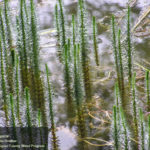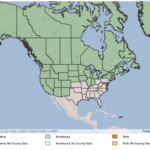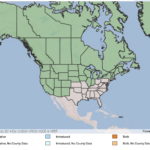Hippuris vulgaris
Illustration: USDA-NRCS PLANTS Database / Britton, N.L., and A. Brown. 1913. An illustrated flora of the northern United States, Canada and the British Possessions. 3 vols. Charles Scribner’s Sons, New York. Vol. 2: 612.
What is Mare’s-tail?
Physical Characteristics
Leaves:
- Whorled
- 0.39-4 inches long
- Linear
- Green-reddish in color
Flowers:
- Small flowers, appearing in the leaves
Fruit:
- Small
- Egg-shaped
- Nut
Stem:
Where Does it Grow?
USDA, NRCS. 2024. The PLANTS Database (http://plants.usda.gov). National Plant Data Team, Greensboro, NC 27401-4901 USA.
Mare’s tail can be found in the cold waters of ponds.
Pros and Cons of Mare’s-tail
Submerged portions of all aquatic plants provide habitats for many micro and macro invertebrates. These invertebrates in turn are used as food by fish and other wildlife species (e.g. amphibians, reptiles, ducks, etc.). After aquatic plants die, their decomposition by bacteria and fungi provides food (called “detritus”) for many aquatic invertebrates.





